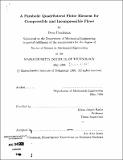A parabolic quadrilateral finite element for compressible and incompressible flows
Author(s)
Hendriana, Dena
DownloadFull printable version (9.869Mb)
Advisor
Klaus-Jürgen Bathe.
Terms of use
Metadata
Show full item recordAbstract
A unified finite element solution scheme for incompressible and compressible flows would be most attractive in engineering practice. The objective in this thesis was to work toward this goal. A 9-node finite element for compressible and incompressible 2-D flow solutions is presented. In the compressible flow formulation, a new high-order derivative artificial diffusion and a new shock capturing term are employed to stabilize the formulation. The new upwinding term is shown numerically to stabilize the formulation and an inf-sup test is performed assuming idealized 1-D conditions. The new shock capturing term performed well in the solutions of various judiciously selected numerical examples. Various flow problems in which the Mach numbers range from about 0.0005 to 6 are considered. The numerical results indicate that the element is applicable to a wide range of analysis problems. For incompressible flows, the element must satisfy the relevant inf-sup condition, and an element is used with parabolic velocity and linear pressure interpolations (the 9/4c-element). An upwinding term in a similar form as for the compressible flow solution is introduced to stabilize the formulation. A convergence study with the formulation to estimate the order of convergence is performed. In addition, a new low order element is presented. The new solution schemes for compressible and incompressible flows provide effective solution techniques and the study provides insight into the difficulties encountered in the development of a unified scheme for incompressible and compressible flows.
Description
Thesis (Sc.D.)--Massachusetts Institute of Technology, Dept. of Mechanical Engineering, 1998. Includes bibliographical references (leaves 156-161).
Date issued
1998Department
Massachusetts Institute of Technology. Department of Mechanical EngineeringPublisher
Massachusetts Institute of Technology
Keywords
Mechanical Engineering